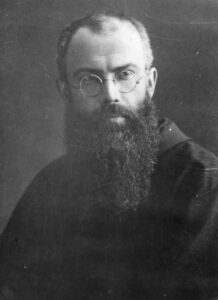
Internet Legends
When it comes to the relics of St Maximilian Kolbe, the fictions are certainly stranger than the truth. A recent web search (October 2013) for “first-class relics of Maximilian Kolbe” turned up assertions ranging from the simple statement that “no first-class relics” of the saint exist, to stories that would make the most fanciful medieval hagiographer envious. When Internet hagiographers acknowledge the existence of relics of St Maximilian, they get one detail right: first-class relics of St Maximilian are hairs, clipped and saved by someone other than St Maximilian himself. (We will pass over without comment the person who claims to have what very well could be St Maximilian’s ashes, collected from Auschwitz very shortly after Maximilian was cremated.) Beyond that, the details are only limited by the imagination – and ignorance (or pious credulity) – of the person telling the story.

A YouTube video, for example, claims that only two first-class relics of Maximilian exist, one in the United States and one in the Vatican. The presenter claims that both relics are hairs of St Maximilian, but does not stop to consider how microscopically tiny the hairs must be if the original hair could only be divided into two pieces, or how such a minute hair could have been authenticated as belonging to St Maximilian and preserved for several decades before Maximilian was beatified. The presenter also never questions why the friars at Niepokalanów would not have kept at least one first-class relic at the sanctuary established by St Maximilian. The prize for “most imaginative” (and least credible) story goes to the online hagiographer who reports that “one of the Nazis” who was “a former Catholic” made it his special business to see to it that “the body of the saint and all his belongings were burnt so that there would be no relics.” We can stop there and wonder how the story-teller knows that the Nazi was a former Catholic, but cannot supply us with his name. We may also wonder how any prisoner in Auschwitz had “belongings” to be burned. Never mind – the story stretches credulity further: it seems that when the unnamed Nazi had personally seen to it that Maximilian’s body and belongings were burnt, the saint’s beard miraculously refused to burn! (Just ignore the fact that prisoners in concentration camps were shaved immediately upon arrival as part of the delousing process and that nearly two tons of human hair are thus preserved at Auschwitz to this day.) The conclusion to this amazing story is simple: “thus the only first-class relic we have of this great Franciscan saint is part of his beard.” Certain small details are unexplained: Who preserved the relics? How were they preserved in a concentration camp from 1941, when Maximilian died, to 1945, when Auschwitz was liberated? How were the relics authenticated, and by whom?
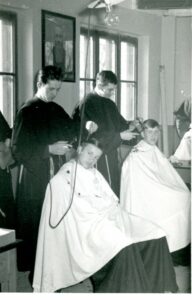
When people get the story of St Maximilian’s relics more or less right, it goes something like this: Once upon a time, someone was cutting Maximilian’s hair (usually it’s a friar; once it was a barber in Rome when Maximilian was a seminarian; another story places the haircut in Japan; yet another has the haircut happening after Maximilian’s death and before his cremation in Auschwitz). The anonymous barber, recognizing that Kolbe would one day become a saint, decides to preserve the hair clippings (or beard clippings). Maximilian Kolbe finds out about this and is outraged (or amused or disturbed) and tells the barber to throw the hairs into the stove (this exchange is in almost every story, however there is absolutely no record that it happened). The barber obediently throws the hairs into the stove, and what happens next varies. In the YouTube “only two relics” version, Maximilian was killed very soon after, before anyone had any reason to light the stove, and so the hairs were saved. In most other versions, either some of the hair doesn’t burn, or the barber snatches it out of the fire after Maximilian leaves the room, or the barber obediently throws the hair into the stove, but the crafty fellow doesn’t light the fire! And so the relics live happily ever after.
What’s the Truth?
The true story of St Maximilian’s relics can be found in the written statements of the persons involved which are preserved in the archives at Niepokalanów.
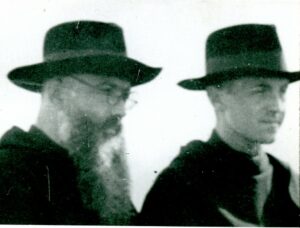
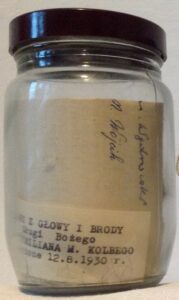
The story begins with the Conventual Franciscan friar Kamil Banaszek, at the friary of Niepokalanów in 1930. Brother Kamil had various regular duties in the friary such as secretary, photographer and chronicler. In addition, he served as barber, cutting the hair of Father Maximilian Kolbe on August 12, 1930, when Fr Maximilian had returned from his first trip to Japan. Because of his personal devotion to Father Maximilian, who was generally considered to be very holy, Brother Kamil discreetly preserved Fr Maximilian’s hair in an envelope. Fr Maximilian had no idea that Brother Kamil had done this. Brother Kamil labeled the envelope in his own hand, “hair of the head and beard of Father Maximilian Kolbe cut by Brother Kamil Banaszek on August 12, 1930, i.e., before the second trip to Japan.” (In 1952, Brother Zenobiusz Gacek found this envelope while organizing the friary’s archives. The handwriting on the envelope was compared with Brother Kamil’s handwriting and confirmed to be authentic.)
The Sworn Statement of Brother Zenobius Gacek
SWORN STATEMENT
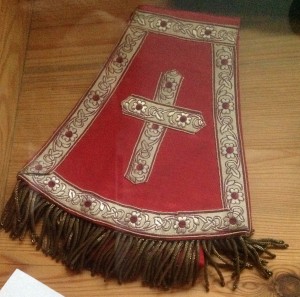
while distributing Holy Communion
On the authenticity of the hair of the head and beard of the Servant of God Father Maximilian Kolbe OFM Conv., cut on August 12, 1930. In 1952, as Deputy Secretary of Committee I (MI) while organizing the archive where we preserve records and documents of the deceased members of the community, I found a sealed envelope with a handwritten inscription on the outside reading, “hair of the head and beard of Father Maximilian Kolbe cut by Brother Kamil Banaszek on August 12, 1930, i.e. before the second trip to Japan [in 1930].” Knowing that the writings and other memorabilia of the Servant of God Father Maximilian were being collected by the documentation committee, I placed the envelope and its contents in their archives.
I, the undersigned, with my hand on the Gospels, swear to God the Most High, that my statement above is true.
Br Zenobius Maria Gacek
After opening a wax-sealed envelope personally delivered to us by Brother Zenobius Gacek, we found that it contained dark-colored hair with a small amount of gray hair. On the outside was a handwritten inscription, which we ascertained to have been written by Brother Kamil Banaszek by comparing the writing to other texts written by him. Inside the envelope was smaller envelope measuring 122 x 72mm and on the outside of it was the handwritten inscription of Brother Kamil Banaszek reading, “Hair of the beard on August 12, 1930 on the eve of departure for the mission.” This envelope contained a small amount of dark hair and a few white hairs. Since the larger envelope was damaged, to keep the hair from being lost, we put it in a glass jar and screwed down the lid. We placed the small envelope with its entire contents into the same jar. The hair has been preserved in this state to the time of preparing these statements.
I, the undersigned, with my hand on the Gospels, swear to God the Most High, that the statement above regarding the acceptance and storage of hair from the head and beard of the Servant of God, Father Maximilian Kolbe, is true.
Br Arnold M. Wędrowski
Br Innocenty M. Wójcik
Fr Izydor Kożbiał, Guardian
Oath I received, [Seal] Niepokalanów, 19.4.1961
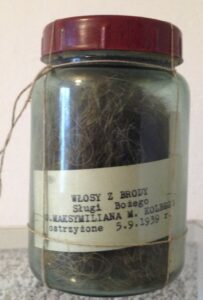
On August 25, 1930, Fr Maximilian again left for Japan, returning to Poland for the last time in 1936. In those days, Conventual Franciscans remaining in Poland normally were clean-shaven with close-cropped hair. However, missionaries often allowed their beards to grow. Fr Maximilian continued to wear a beard after his return from the mission fields until early September 1939, when his provincial, Fr Maurycy Madzurek, advised Fr Maximilian to cut off his distinctive, long, luxuriant beard in order to avoid easy recognition and potential harassment by the Nazis, who had invaded Poland on September 1. On September 5, Fr Maximilian once again availed himself of Br Kamil Banaszek’s tonsorial skills, having his beard lopped off and getting a shave. Again unbeknownst to Fr Maximilian, out of a sense of reverence for the future martyr, Br Kamil saved Fr Maximilian’s beard. As Br Kamil explained to Br Gabriel Siemiński, with whom he shared a cell for several years, “after cutting off the beard, out of the devotion I felt for the Beloved Father, I quietly took the hair and have kept it to this day as my most precious treasure” (translated from Br Gabriel Siemiński’s sworn statement taken on April 19, 1961). Before he died on June 27, 1945, Br Kamil entrusted the relic of Fr Maximilian to Br Gabriel for safe-keeping. Brother Gabriel duly preserved the hair from Fr Maximilian’s beard until 1946, when he turned it over to the committee documenting the life of Fr Maximilian Kolbe. The hair was placed in a glass jar, the lid was screwed onto the jar and the jar was sealed with melted wax.
The Sworn Statement of Brother Gabriel Siemiński
SWORN STATEMENT
On the authenticity of the locks of hair of the Servant of God Father Maximilian Kolbe OFM Conv., cut September 5, 1939. Beginning in August 1930 I lived for several years in the same cell as Brother Kamil Banasezk, who from the years 1936-1940 had the following duties: an executive secretary, personal secretary, chronicler and photographer. In addition to his regular duties, he cut the hair of Maximilian Kolbe until Kolbe was arrested for the second time, that is February 17, 1941.
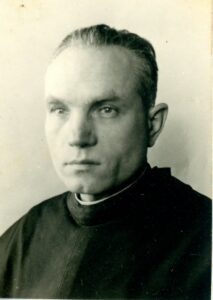
Brother Kamil Banaszek once confided to me that he had the beard of Father Maximilian Kolbe, which had been cut off in the first days of the war, that is, September 5, 1939. To avoid Fr Maximilian being recognized and suffering unpleasantness from the Germans, the Provincial, Fr Maurice Madzurek, told Fr Maximilian to completely cut off the beard which he had worn from the time he went as a missionary to Japan, that is, from February 1930. Brother Kamil told me that “after cutting off the beard, out of the devotion I felt for the Beloved Father, I quietly took the hair and have kept it to this day as my most precious treasure.” At the end of June 1945 the terminally ill Brother Kamil Banaszek was taken to the hospital in Sochaczew. He personally gave me the hair from the beard of Father Maximilian Kolbe, urgently requesting that I safeguard this unique relic. Brother Kamil Banaszek died in hospital June 27, 1945. I carefully preserved the hair from the beard of the Servant of God, and in 1946 I gave this precious relic to the committee documenting the life of Father Maximilian Kolbe.
I, the undersigned, with my hand on the Gospels, swear to God the Most High that my statement that these are the authentic locks of hair of the Servant of God, Father Maximilian Kolbe, is true.
Br Gabriel Siemiński
We received the hair from the beard of the Servant of God, Father Maximilian Kolbe from Brother Gabriel Siemiński in October 1946. We put the hair in a glass jar, screwed the lid closed and poured wax over it. It has been preserved in this state since then.
I, the undersigned, with my hand on the Gospels, swear to God the Most High, that the statement above about the reception and preservation of the hair of the Servant of God, Father Maximilian Kolbe, is true.
Br Arnold Wędrowski
Br Innocenty Wójcik
Oath I received,
Fr Izydor Kożbiał, Guardian [Seal] Niepokalanów, 19.4.1961
In December, 1940, Br Arkursy Pruszak cut Fr Maximilian’s hair and preserved it in a piece of paper. He kept the hair throughout the War and after, until September 15, 1967, when he turned it over to the committee documenting Fr Maximilian’s life. The hair from Fr Maximilian’s head, wrapped in paper, was preserved in a glass jar with a screw top.

The Sworn Statement of Brother Arkursy M. Pruszak
SWORN STATEMENT
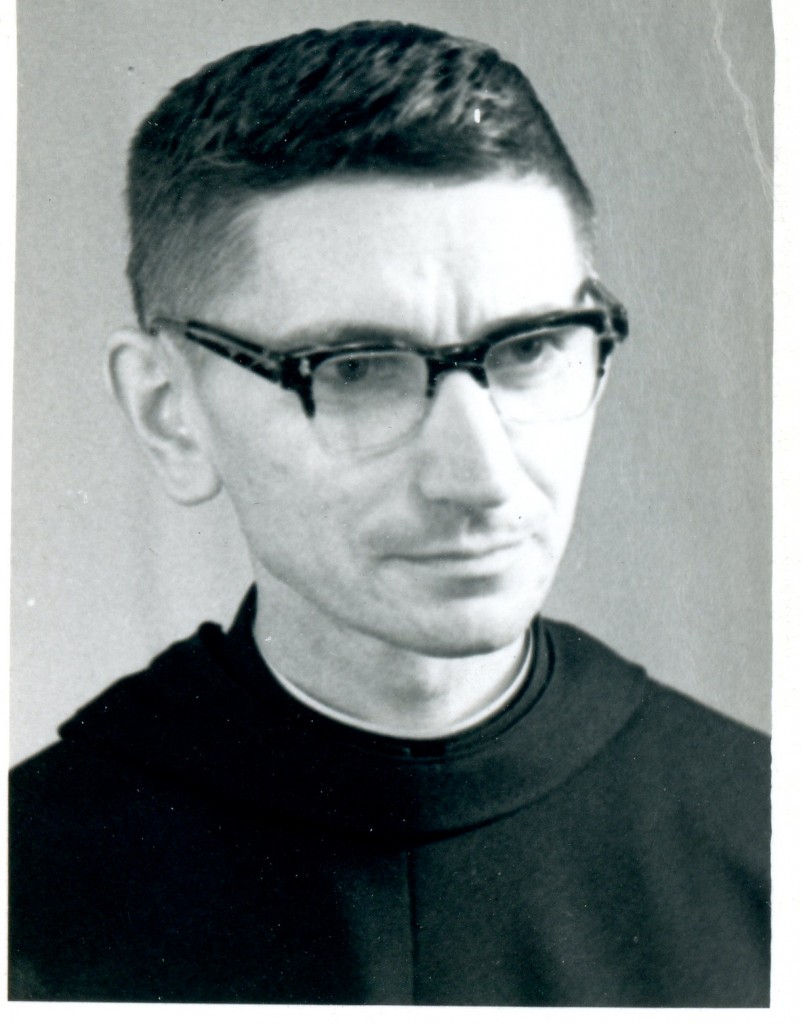
On the authenticity of hair from the head of the Servant of God by Maximilian Kolbe, cut in 1940. In December 1940, I was a barber in Niepokalanów and trimmed the hair of Father Maximilian in his cell. I collected the hair as a precious keepsake and kept it throughout the war and the German occupation until now, that is, September 15, 1967. Today I have the hair to the Documentation Committee of Father Maximilian Kolbe for permanent storage.
I, the undersigned, with my hand on the Gospels, swear to God the Most High, that my statement above is true.
Br Arkusy M. Pruszak
I received hair from the head of Maximilian Mary Kolbe, wrapped in paper from Brother Arkursy Pruszak. I put it into a glass jar with a screw top.
Br Innocenty Maria Wójcik [Seal]
Oath I received,
Fr Georgius M. Domański, Guardian Niepokalanów, 26.9. 1967
As can be inferred from the historic record and the photographs, there is no shortage of first-class relics of St Maximilian Kolbe. According to the archivist at Niepokalanów, relics have been distributed continually since Maximilian was beatified in 1971 (more than 80 thus far in 2013 alone). Approximately 1,000 first-class relics of St Maximilian are venerated around the world.
How to Obtain a First-Class Relic of St Maximilian
Parishes or institutes that wish to have a relic of St Maximilian Kolbe must send official, signed and sealed request assuring public veneration of the relic to Father Guardian OFM Conv., Niepokalanów, 96-595 Teresin, Poland or contact Niepokalanów by e-mail for more information: klasztor@niepokalanow.pl. Relics must be received in person for the purpose of public veneration. Relics are never sold; however, it is customary to make a freewill offering when receiving a relic. Special requests for second-class relics (material from shirt or habit) may be considered. For information, write to archiwum@niepokalanow.pl. (NB: The Pastoral Centre for English-Speakers does not distribute relics of any saint, in any degree – first- second- or third-class – nor do we have any holy cards, medals or other objects available for distribution by mail.)
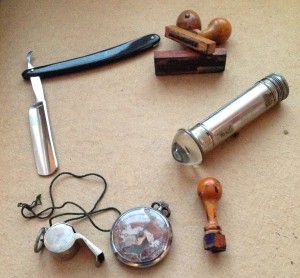
preserved at Niepokalanów
Second-class relics of St Maximilian such as his clothing and personal effects can be seen in Niepokalanów in the cell occupied by Maximilian from 1936-1940. Liturgical vestments and chalices are displayed in the St Maximilian Chapel at Niepokalanów. Third-class relics (material that has been touched to the saint’s hair) can be obtained from the bookstore at Niepokalanów and are easily available by mail-order through online stores in the US.
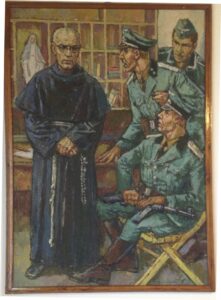
“There is nothing concealed that will not be revealed, nor secret that will not be known. Therefore whatever you have said in the darkness will be heard in the light, and what you have whispered behind closed doors will be proclaimed on the housetops. I tell you, my friends, do not be afraid of those who kill the body but after that can do no more. I shall show you whom to fear. Be afraid of the one who after killing has the power to cast into Gehenna; yes, I tell you, be afraid of that one. Are not five sparrows sold for two small coins? Yet not one of them has escaped the notice of God. Even the hairs of your head have all been counted. Do not be afraid. You are worth more than many sparrows. I tell you, everyone who acknowledges me before others the Son of Man will acknowledge before the angels of God. But whoever denies me before others will be denied before the angels of God” (Luke 12:2-9).
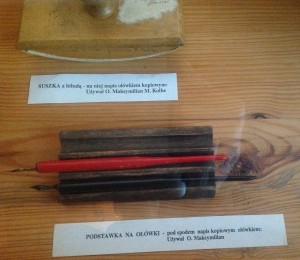
The information and historical documents used in this text came from the archives of the Conventual Franciscan community at Niepokalanów, Poland. We are especially grateful for information, inspiration and the generous help of Sr Annamaria Mix, OV, archivist at Niepokalanów, and to the rector of the Pastoral Centre for English Speakers, Fr Krzysztof Kukułka, OFM Conv., who went to Niepokalanów to take photos and gather historical records used in this text. The photographs in this article are the property of the Franciscan community at Niepokalanów or of Fr K. Kukułka (as noted on photos). The Pastoral Centre is happy for others to quote this article or reproduce photos on your own website. We ask that any use of the materials on this page be credited and a link be given to the Pastoral Centre for English Speakers in Wrocław, Poland: www.pastoralcentre.pl.
